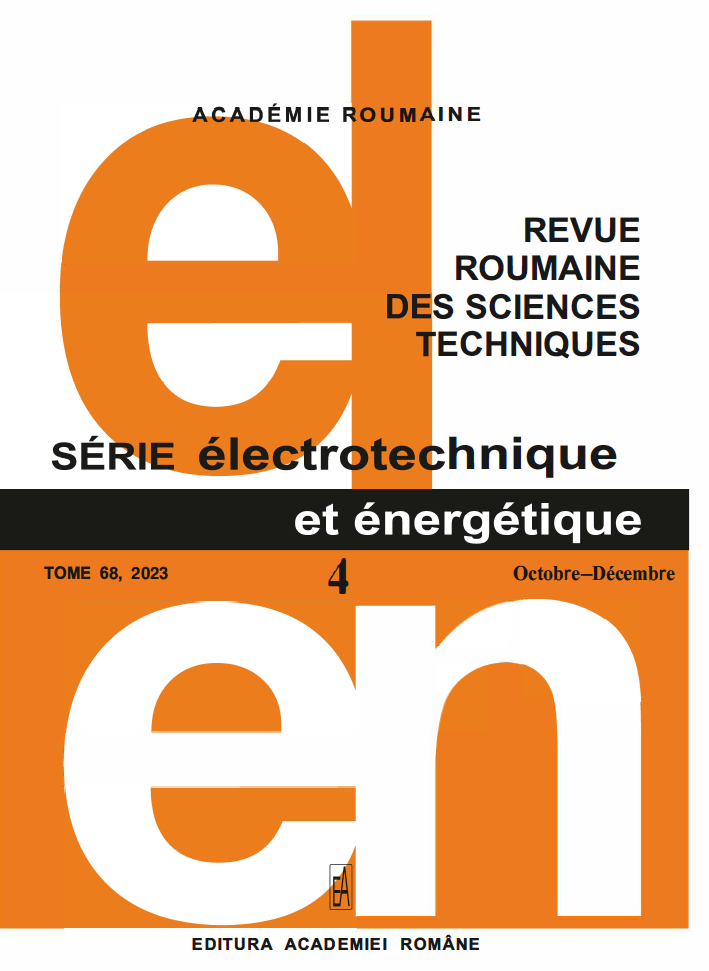MODÉLISATION ET CLASSIFICATION DES DÉFAILLANCES DES ÉOLIENNES À L'AIDE DE RÉSEAUX NEURONAUX MODULAIRES OPTIMISÉS PAR COUCOU
DOI :
https://doi.org/10.59277/RRST-EE.2023.4.8Mots-clés :
Éolienne, Accéléromètre piézoélectrique, Détection de fautes, L'apprentissage en profondeur, Réseau neuronal modulaireRésumé
L'éolienne est rapidement devenue l'une des sources d'énergie renouvelables les plus importantes au monde. Les éoliennes doivent être massives pour augmenter les quantités d'énergie électrique. Les pales d’une éolienne sont généralement constituées de matériaux fibreux en raison de leur faible coût et de leur faible poids. Cependant, les pales sont affectées par des rafales de vent, des facteurs climatiques défavorables, des charges de vent incertaines, des orages et des charges gravitationnelles, ce qui entraîne une fissure superficielle de la pale. De ce fait, il est important de surveiller l’état de chaque éolienne et son état de défaut de localisation. Dans cette recherche, un réseau neuronal modulaire optimisé pour le coucou (COMNN) est proposé pour détecter et classer une fissure dans les pales d'une éolienne. La méthode est créée à l’aide d’un accéléromètre piézoélectrique pour calculer la réponse vibratoire de la lame lorsqu’elle est sous tension. L'optimisation Cuckoo est appliquée pour initialiser et ajuster le vecteur de poids du réseau neuronal modulaire. Le résultat expérimental montre que le COMNN détecte et classe avec précision les défauts dans un délai acceptable. Les approches proposées classent le type de défaut avec une précision 98,1 % supérieure aux techniques existantes, telles que les réseaux de neurones convolutifs (CNN), les réseaux de neurones récurrents (RNN) et les algorithmes de réseau de neurones artificiels ANN + support vector machine (SVM).
Références
(1) T.H. Van, T. Le Van, T.M.N. Thi, M.Q. Duong, G.N. Sava, Improving the output of dc-dc converter by phase shift full bridge applied to renewable energy, Revue Roumaine Des Sciences Techniques—Série Électrotechnique Et Énergétique, 66, 3, pp.175–180 (2021).
(2) P. Deepa, S. Rajakumar, P.J. Shermila, E.A. Devi, M.E. Prince, A.J.G. Malar, New hybrid Cuk-Landsman high gain dc-dc converter modelling and analysis, Power, 9, 8, pp. 8–16 (2022).
(3) 3 Z. Dekali, L. Baghli, A. Boumediene, Experimental implementation of the maximum power point tracking algorithm for a connected wind turbine emulator, Revue Roumaine Des Sciences Techniques—Série Électrotechnique Et Énergétique, 66, 2, pp.111–117 (2021).
(4) D. T. Griffith, N. C. Yoder, B. Resor, J. White, J. Paquette, Structural health and prognostics management for the enhancement of offshore wind turbine operations and maintenance strategies, Wind Energy, 17, 11, pp. 1737–1751 (2014).
(5) G. Isha, P. Jagatheeswari, A.J.G. Malar, Elitist Harris hawks optimized voltage stability enhancement in radial distribution system, J. Electr. Eng. Technol., 18, 2683–2693 (2023).
(6) W. Li, D. Deka, M. Chertkov, M. Wang, Real-time faulted line localization and PMU placement in power systems through convolutional neural networks, IEEE Transactions on Power Systems, 34, 6, pp. 4640–4651 (2019).
(7) S. Na, N. Kishor, K. Uhlen, S. R. Mohanty, Detecting instant of multiple faults on the transmission line and its types using time–frequency analysis, IET Generation, Transmission & Distribution, 13, 22, pp. 5248–5256 (2019).
(8) A.J.G. Malar, C.A. Kumar, A.G. Saravanan, IoT-based sustainable wind green energy for smart cities using fuzzy logic based fractional order Darwinian particle swarm optimization, Measurement, 166, pp. 108208 (2020).
(9) S. Zare, M. Ayati, Simultaneous fault diagnosis of wind turbine using multichannel convolutional neural networks, ISA Transactions, 108, pp. 230–39 (2021).
(10) S. Cho, M. Choi, Z., Gao, T. Moan, Fault detection and diagnosis of a blade pitch system in a floating wind turbine based on Kalman filters and artificial neural networks, Renewable Energy, 169, pp. 1–13 (2021).
(11) S. Guo, T. Yang, H. Hua, J. Cao, Coupling fault diagnosis of wind turbine gearbox based on multitask parallel convolutional neural networks with overall information. Renewable Energy, 178, pp. 639–650 (2021).
(12) M. Nithya, S. Nagarajan, P. Navaseelan, Fault detection of wind turbine system using neural networks, in Proc. IEEE Technological Innovations in ICT for Agriculture and Rural Development (TIAR), pp. 103–108 (2017).
(13) G. Jiang, H. He, J. Yan, P. Xie, Multiscale convolutional neural networks for fault diagnosis of wind turbine gearbox, IEEE Transactions on Industrial Electronics, 66, 4, pp. 3196–3207 (2018).
(14) J. Liu, F. Qu, X. Hong, H. Zhang, A small-sample wind turbine fault detection method with synthetic fault data using generative adversarial nets, IEEE Transactions on Industrial Electronics, 15, 7, pp. 3877–3888 (2018).
(15) L. Xiang, P. Wang, X. Yang, A. Hu, H. Su, Fault detection of wind turbine based on SCADA data analysis using CNN and LSTM with attention mechanism, Measurement, 175, pp. 109094 (2021).
(16) Y. Miao, M. Zhao, K. Liang, J. Lin, Application of an improved MCKDA for fault detection of wind turbine gear based on encoder signal, Renewable Energy, 151, pp. 192–203 (2020).
(17) Y. Wang, X. Ma, P. Qian, Wind turbine fault detection and identification through PCA-based optimal variable selection, IEEE Transactions on Sustainable Energy, 9, 4, pp. 1627–1635 (2018).
(18) A. Agasthian, R. Pamula, L. A. Kumaraswamidhas, Fault classification and detection in wind turbine using cuckoo-optimized support vector machine, Neural Computing and Applications, 31, 5, pp. 1503–1511 (2019).
(19) J. Guo, C. Liu, J. Cao, and D. Jiang, Damage identification of wind turbine blades with deep convolutional neural networks. Renewable Energy, 174, pp.122–133 (2021).
(20) X.S. Yang, S. Deb, M. Karamanoglu, X. He, Cuckoo search for business optimization applications, National Conference on Computing and Communication Systems, Durgapur, India, pp. 1–5 (2012).
(21) X.S. Yang. Cuckoo Search and Firefly Algorithm: Theory and Applications, London, Springer, 516, pp. 366 (2013).
(22) I. Şerban, C. Marinescu, Power quality issues in a stand-alone microgrid based on renewable energy. Rev. Roum. Sci. Techn.–Électrotechn. et Énerg, 53, 3, pp. 285–293 (2008).
Téléchargements
Publiée
Numéro
Rubrique
Licence
(c) Copyright REVUE ROUMAINE DES SCIENCES TECHNIQUES — SÉRIE ÉLECTROTECHNIQUE ET ÉNERGÉTIQUE 2023

Ce travail est disponible sous licence Creative Commons Attribution - Pas d'Utilisation Commerciale - Pas de Modification 4.0 International.


